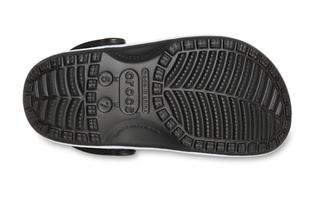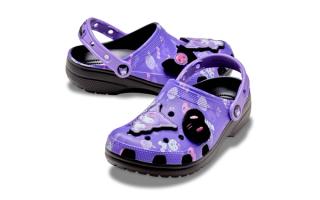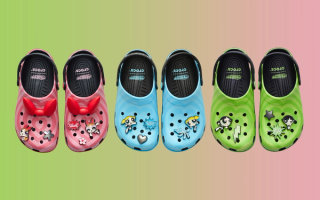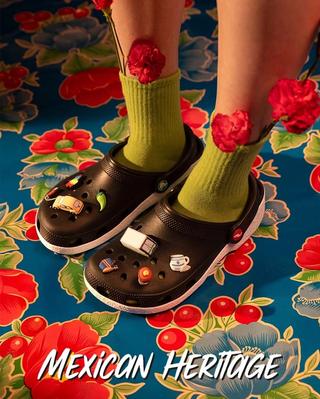
A la...Crocs Presents the Classic Clog "Mexican Heritage"
Release
2025.08.29
Heat
99.70°
Brand
Model
SKU
211986-0C4
Color
Black/White/Multi-Color
Retail
$102
Whether you like it or not, Mexico's influence in the United States of America is baked into the very fabric of the country. Political affairs between the neighbors have seen better days, but Crocs has curiously taken the first-half of 2025 to develop a Classic Clog inspired by the republic down south.
Perhaps part of an expansive collection dedicated to different counties across the globe, the commemorative pair features a rather underwhelming "Black/White" color scheme across its Croslite™ upper and slip-resistant tooling. Even the tri-colored Mexico text on the heel is too on the nose to make the Crocs Classic Clog special. But it is, thanks to the deceptively simple Jibbitz™ charms accompanying the pair.
Colorful piñatas and green chiles arrive attached to the playful design, alongside other emblematic symbols of the country that might not be fully appreciated unless you've visited. Lucky for you, House of Heatº's got you covered with a brief cultural lesson.
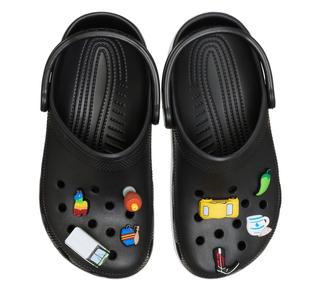
A total of eight different charms inspired by Mexico—its culture and gastronomy—arrive with the Classic Clog. Jibbitz™ shaped like cowboy boots and a mug of hot chocolate reference the states of Chihuahua and Puebla, respectively. You don't have to be an expert on the Latin American country to know of either of these two items' connection to it, but having more context certainly enables a deeper understanding and appreciation of their inclusion in the pair.
The boots with punta larga (long toe) differ from traditional Western wear. Folks from the northern Mexican state take pride in the ornateness of their botas vaqueras, with the longer, pointed toe making a double-statement. The concha-accompanied mug is equally ornate, as its white-and-blue color scheme draws inspiration from the talavera ceramic style historically important to Tlaxcala (sí existe) and nearby Puebla, two central states in the country.
If you ever find yourself at an artisanal market in Mexico, you're sure to find similar mugs for sale. Other items done in the talavera style brought from Europe during the Spanish Conquest of the region include: flower pots, salt shakers, butter holders, plates, and, of course, shot glasses.
The aforementioned piñata and green-colored peppers might be stereotypical of the country, but they're still important.
Piñatas are sold all year round in Mexico, but are particularly popular during birthdays, baptisms, and the nine-day stretch before Christmas Day. Some folks also ring in Independence Day (Sept. 16) by gathering together to break piñatas, drink, eat, and celebrate their country.
Not every chile used in Mexican cuisine is spicy, but those that are, really test even the biggest picante-aficionado's tolerance. This is your sign to try out a dish with salsa verde next time you encounter food from Mexico.

One such dish that could benefit from spicy green salsa is tacos al pastor. Similar to the adobada tacos sold throughout the U.S., al pastor is most popular in the country's capital. And the options are infinite.
This style of taco is prepared by marinating pork with achiote, chiles rojos, and spices. Cuts of the meat are layered on top of each other and propped up on a vertical spit, which is recreated as a charm on the impending Crocs Classic Clog.
The al pastor trompo is then slow-roasted by a taquero, who must be skilled in handling the spit. A piece of pineapple is often found at the top of the trompo, as the al pastor meat is accompanied by the tropical fruit, cilantro, and onions.
If you're thinking al pastor sounds (and looks) a lot like shawarma, you're onto something: Lebanese immigrants who landed in Mexico throughout the 1920s brought the dish and its style of cooking to their new home. Lamb, however, was replaced with pig in order to better accommodate the local palate.
The Mexico-inspired slip-on also features charms not in the shape of food. An iconic toy and two different automobiles join the mix, delivering cheeky nods to the republic.
If you've ever watched any iteration of Roberto Gómez Bolaños's El Chavo del Ocho, you should recognize the balero included with the Classic Clog. While largely replaced by tablets and other handheld devices today, the cup-and-ball-like traditional pastime is still sold throughout the country, with many baleros also collecting dust in homes as generations pass.
At quick glance, the yellow-colored car seems like a random, New York City taxi-like add-on, but it's not. The Jibbitz™ references the Volkswagen Type1—also known as the VW Beetle—that arrived to Mexico in October 1967 and is still seen throughout the country today. The vocho verde served as the capital's most common taxi in past decades, with the vocho amarillo preceding it. It was also at the center of an older generation's game during youth. "Punch buggy" and "slug bug" were the equivalents across the U.S., but Mexicans focused on the yellow Beetle to dish out punches as it was rare.

The second vehicle referenced by the Classic Clog doesn't have as great a reputation as Volkswagen's Beetle, but it's equally important to the country.
Honing in on Ciudad de México's metropolitan area, 20 million inhabitants must move around on the daily. A city-operated public transportation system does a great job of getting folks to their destinations (albeit cramped and sweaty), but there are some corners of the capital that aren't serviced by the Sistema de Movilidad Integrada. For these such cases, a lot of citizens rely on the privately-owned microbús system.
Fleets of minibuses operate throughout the city, transporting passengers through backstreets and side roads neglected by much of the city-backed system. And while reliable to some degree, the microbús is widely outdated and unkept, making the ride uncomfortable, but necessary for millions of people every week.
One of the more common models of the pesero—a nickname given to these privately-owned buses due to the fact that rides used to cost one peso throughout the 1960s and '70s—is the AYCO Prisma. Others feature a similar boxy design and pollution-contributing exhaust system.
It's difficult to imagine Mexico without the white-and-green minibus, al pastor trompo, or any other element brought to Jibbitz™ form by Crocs. There's no telling how the country will look like in the next 10 years, but what's certain is that the commemorative Classic Clog will forever capture a moment in time. The pair connects residents to their home, while also bridging the gap ever-so-slightly between those who admire from afar.
In addition to the special charms, the Mexico-inspired Crocs features the country's outline on the heel strap's hinges. Ornate floral shapes are etched into the slip-on's midsole in a similar style to artisanal wares.
Enjoy official photos of the pair below. The "Mexican Heritage" Classic Clog is currently available via Crocs.com in Mexico for the equivalent of $102. A stateside launch could take place soon.
For more footwear inspired by the former home of the Aztecs, check out the black-and-gold Adidas Samba referencing mariachi outfits. If you're a bigger fan of the Jumpman, the Air Jordan 3 "El Vuelo" draws inspiration from lucha libre.





